See the iconic Edinburgh Castle and walk within its walls to view the Scottish Crown Jewels, Stone of Destiny, and Mons Meg.
The Story of Tartans Across Scotland
Patterns, History & Meaning

Tartans are one of the most recognizable symbols of Scotland, deeply woven into the cultural fabric of the nation. These crisscrossed patterns of colored threads, traditionally made from wool, are associated with family heritage, clan loyalty, and Scottish identity. Today, tartans are celebrated globally and worn proudly by people with Scottish ancestry or admiration for the culture, but their history is complex and full of myth.
What is a Tartan? Definition and Characteristics
A tartan is a pattern consisting of horizontal and vertical bands of colors that intersect at right angles, creating a distinctive checked design. Each color combination and arrangement form a unique pattern that distinguishes one tartan from another. Traditionally woven from wool, tartans can now be produced in a variety of materials. The defining characteristic of tartan is its repetition of the same set of stripes in both directions of the fabric.
The Symbolism Behind Tartans
Tartans have long held deep symbolic meaning in Scotland. Historically, different patterns were associated with specific clans, regions, or military regiments. Wearing one’s tartan is an expression of loyalty and pride in family or community while also reflecting the long-standing tradition of identifying oneself through this iconic fabric. Beyond Scotland, tartans are now embraced by people around the world as symbols of heritage, fashion, and personal identity.

The Origins of Tartan in Scotland
Early Fabric Weaving in Ancient Scotland
The practice of weaving fabrics in Scotland dates back thousands of years. Early examples of checked patterns have been found in prehistoric sites throughout Scotland, indicating that simple forms of tartan were used long before the clan system developed. The earliest tartans likely evolved from practical weaving techniques, with patterns emerging because of the intersection of colored threads in the loom.
Influence of Natural Dyes and Wool
Natural dyes derived from plants, berries, and minerals in Scotland gave early tartans their earthy green, brown, blue, and red tones. The abundance of sheep in the Highlands provided a reliable source of wool, the primary material used for weaving tartans. Over time, these natural elements shaped the colors and patterns that came to be associated with different regions of Scotland.
The Transition from Simple Checks to Modern Tartans
Simple checkered patterns were commonly worn across Scotland in the early medieval period. These early designs were largely functional and used for clothing and blankets. Over time, as weaving techniques became more advanced, more intricate patterns emerged. By the 16th and 17th centuries, what we recognize as modern tartan patterns were beginning to take shape, with regional variations becoming more distinct.
Tartan Weaving and Craftsmanship
The Art of Weaving Tartans: Techniques and Traditions
Weaving tartan is an art form that requires both skill and precision. Traditionally, tartans were woven by hand on looms, with each pattern requiring a specific thread count and order of colors. This craftsmanship has been passed down through generations, with many weavers continuing to practice the traditional methods.
Famous Tartan Weavers and Manufacturers
Scotland is home to many famous tartan weavers and manufacturers, such as Lochcarron of Scotland and Johnstons of Elgin, which have been producing tartan for centuries. These companies preserve traditional tartan weaving methods while innovating to meet modern demands.
Types of Scottish Tartans
Dress Tartans vs. Hunting Tartans
Traditionally, tartans were classified into categories like dress tartans, which were lighter and more decorative, and hunting tartans, which were darker and more muted, often worn during outdoor activities. While the distinctions are not as rigid today, many tartan patterns still reflect these historical categories.
Regional Tartans and District Tartans
In addition to clan tartans, there are regional or district tartans, representing specific areas of Scotland rather than families. For example, the Edinburgh tartan represents the capital city, while the Isle of Skye tartan reflects the island's unique landscape.
Military and Royal Tartans
The military has long used Tartan, with specific regiments adopting their own patterns. The Black Watch tartan, one of the most famous, was originally worn by the Black Watch regiment. In contrast, royal tartans like the Royal Stewart tartan are associated with the British royal family.

Tartan in Scottish Ceremonies and Celebrations
Tartans in Highland Games and Cultural Festivals
Tartan plays a central role in Scotland’s Highland Games and other cultural festivals. Competitors and attendees alike often wear their clan tartans to celebrate their heritage and show pride in their Scottish identity. Events like the Edinburgh Military Tattoo also dramatically showcase tartan.
Weddings, Funerals, and National Ceremonies
Tartan remains an integral part of Scottish ceremonies, particularly weddings and funerals. Wearing a tartan kilt at a wedding is a long-standing tradition, while tartan sashes are often worn at other formal events. Tartans are also featured in state ceremonies, adding to their continued relevance in modern Scotland.
Tartan’s Role in Clan Identity
The Myth of Clan-Specific Tartans
One of the most enduring myths about tartans is that each Scottish clan has always had its own distinct tartan. While clan tartans are an essential part of modern Scottish culture, this concept is a relatively recent invention. Before the 19th century, tartans were primarily regional, and people would wear patterns based on the dyes and weavers available in their area rather than a strict association with a specific family.
How Tartans Came to Represent Scottish Clans
The idea of tartans representing clans began in the 18th and 19th centuries, particularly following the Jacobite uprisings and the subsequent romanticization of Highland culture. As Scotland sought to preserve its heritage in the face of political change, tartans became a symbol of clan pride. The publication of books on tartan patterns in the 1800s helped formalize the connection between specific patterns and Scottish families.
Famous Clan Tartans and Their Histories
Some of the most famous clan tartans include the MacDonald, Campbell, and MacLeod tartans. Each pattern is tied to the history and lore of its respective clan. For example, the MacDonald tartan is one of the most recognizable, with bold red, green, and black stripes. In contrast, the Campbell tartan, with its dark blue and green tones, reflects the storied history of the Campbell clan, one of the largest and most powerful in Scotland.
Tartan in Scottish Warfare and Politics
The Use of Tartan in the Jacobite Uprisings
During the Jacobite Risings in the 17th and 18th centuries, tartan became closely associated with Highland warriors who supported the Stuart claim to the British throne. Highland soldiers often wore tartan into battle, and the distinctive patterns helped foster a sense of unity among the Jacobite forces. This association with rebellion also caused tartan to be viewed as a symbol of defiance against British rule.
Tartan as a Symbol of Defiance Against British Rule
After the Jacobites were defeated at the Battle of Culloden in 1746, the British government sought to suppress Highland culture, which they saw as a threat to the stability of the British Isles. As a result, tartan became a potent symbol of resistance and rebellion against British rule, especially in the Highlands, where clan loyalties remained strong.
The Ban on Tartan: The Dress Act of 1746
In the aftermath of the Jacobite defeat, the British government passed the Dress Act of 1746. It made it illegal for anyone in Scotland to wear "the Highland dress," including tartan unless they were part of the British military. This was part of a broader effort to dismantle the clan system and integrate the Highlands into the rest of Great Britain. The ban lasted for nearly 40 years until it was repealed in 1782 when much of the traditional Highland way of life had changed.
The Revival of Tartan in the 19th Century
The Role of Sir Walter Scott and Romanticism in Tartan’s Revival
The 19th century saw a revival of interest in tartan, largely thanks to Sir Walter Scott, whose romantic novels such as Waverley and Rob Roy painted a nostalgic picture of Scotland’s Highland past. Scott’s work, alongside the broader Romantic movement, led to a resurgence in the popularity of tartan as a symbol of Scottish identity.
Queen Victoria’s Influence on Tartan and Scottish Identity
Queen Victoria played a significant role in the revival of tartan when she and Prince Albert fell in love with the Scottish Highlands and eventually made Balmoral Castle their royal retreat. The royal family’s embrace of tartan, including the design of their own Balmoral tartan, sparked a trend among the British aristocracy, further cementing tartan as a fashionable symbol of Scottish pride.
The Creation of Official Clan Tartans
The Emergence of Clan Tartans in the 1800s
The 19th century saw the formalization of clan tartans, with many families commissioning specific patterns to represent their clan. The Highland Society of London was instrumental in codifying these tartans, publishing records of which patterns were associated with which clans.
Standardizing Tartans: The Role of the Highland Society of London
In the early 1800s, the Highland Society of London began recording official tartans for each clan in an effort to preserve Highland culture. This process helped establish tartan as a key part of clan identity and ensured that the tradition would be passed down through generations.
Registration of Tartans in the Scottish Register of Tartans
In 2008, the Scottish Register of Tartans was established as an official body to preserve, promote, and protect tartan designs. It provides a formal registry for new tartan designs and helps ensure that tartans remain a living tradition in Scotland.
The Global Spread of Scottish Tartans
Scottish Emigration and Tartans Abroad
The mass emigration of Scots in the 18th and 19th centuries helped spread tartan to new parts of the world, particularly North America, Australia, and New Zealand. Scottish expatriates brought their clan tartans with them, and today, the tartan is a popular symbol of Scottish heritage among descendants of these emigrants.
The Influence of Tartans in North America and Beyond
Tartan has significantly impacted fashion in North America, particularly in regions with strong Scottish roots, such as Canada and the United States. Events like Tartan Day, celebrated in many countries, highlight tartan's global influence.
Modern Uses of Tartans in Fashion and Design
Tartan has transcended its Scottish origins to become a staple in global fashion. Designers worldwide have incorporated tartan into their collections, using it in everything from haute couture to everyday clothing. Its timeless appeal and versatility make tartan a popular choice in modern design.

Tartans in Contemporary Scotland
The Role of Tartans in Modern Scottish Identity
In contemporary Scotland, tartans continue to play a key role in national identity. Whether worn as kilts or featured in home decor, tartans are a visible reminder of Scotland’s rich cultural heritage. Tartans are also a source of pride for many Scots, serving as a link to their ancestral past.
Tartan Day and Other Modern Celebrations
Tartan Day, celebrated annually on April 6th, is dedicated to honoring Scottish heritage and the contribution of Scots worldwide. It’s particularly popular in North America, where many people of Scottish descent participate in parades and other celebrations wearing their clan tartans.
Tartans are an enduring symbol of Scotland's rich history and cultural identity. From their origins in ancient weaving techniques to their revival in the 19th century and global spread, tartans have remained a powerful symbol of pride and heritage. Today, they continue to be worn with honor and reverence, both in Scotland and worldwide, representing a connection to the past and a vibrant part of modern life.
Frequently Asked Questions about Tartans
No, not all tartans are associated with clans. There are many regional, military, and royal tartans and modern designs created for fashion or special occasions.
You can search for your clan tartan through resources like the Scottish Register of Tartans, which provides a database of officially registered tartans.
Ancient tartans refer to patterns dyed with natural, muted colors, while modern tartans use brighter, synthetic dyes. Both terms describe the same patterns but with different color palettes.
Yes, after the Jacobite defeat at Culloden in 1746, the Dress Act made it illegal to wear Highland dress, including tartans. The ban lasted until 1782.
To register a new tartan, you can submit your design to the Scottish Register of Tartans, which will be reviewed and added to the official database.
Anyone can wear tartan, and many people worldwide embrace it as a symbol of Scottish culture regardless of their heritage.



















